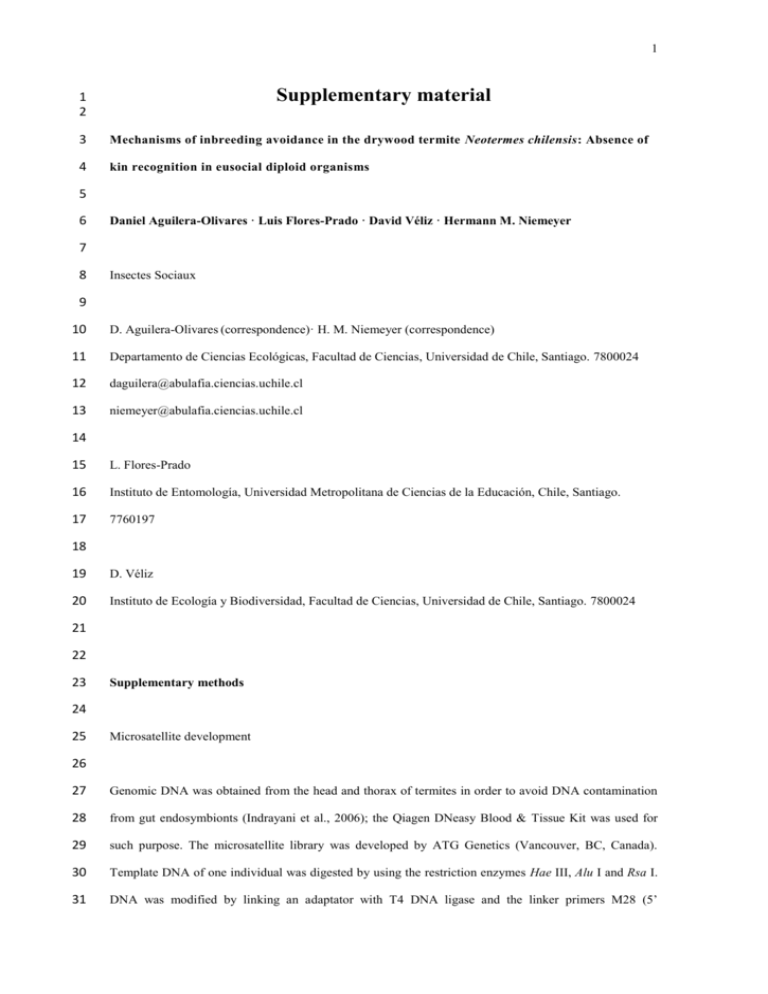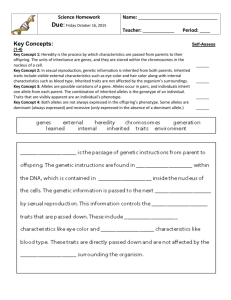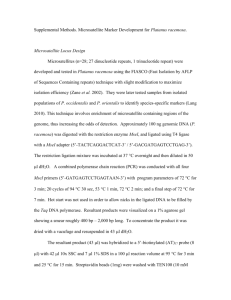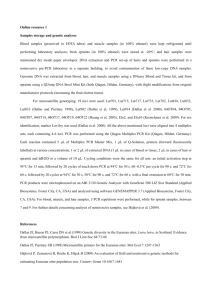Supplementary material - Springer Static Content Server
advertisement

1 Supplementary material 1 2 3 Mechanisms of inbreeding avoidance in the drywood termite Neotermes chilensis: Absence of 4 kin recognition in eusocial diploid organisms 5 6 Daniel Aguilera-Olivares · Luis Flores-Prado · David Véliz · Hermann M. Niemeyer 7 8 Insectes Sociaux 9 10 D. Aguilera-Olivares (correspondence)· H. M. Niemeyer (correspondence) 11 Departamento de Ciencias Ecológicas, Facultad de Ciencias, Universidad de Chile, Santiago. 7800024 12 daguilera@abulafia.ciencias.uchile.cl 13 niemeyer@abulafia.ciencias.uchile.cl 14 15 L. Flores-Prado 16 Instituto de Entomología, Universidad Metropolitana de Ciencias de la Educación, Chile, Santiago. 17 7760197 18 19 D. Véliz 20 Instituto de Ecología y Biodiversidad, Facultad de Ciencias, Universidad de Chile, Santiago. 7800024 21 22 23 Supplementary methods 24 25 Microsatellite development 26 27 Genomic DNA was obtained from the head and thorax of termites in order to avoid DNA contamination 28 from gut endosymbionts (Indrayani et al., 2006); the Qiagen DNeasy Blood & Tissue Kit was used for 29 such purpose. The microsatellite library was developed by ATG Genetics (Vancouver, BC, Canada). 30 Template DNA of one individual was digested by using the restriction enzymes Hae III, Alu I and Rsa I. 31 DNA was modified by linking an adaptator with T4 DNA ligase and the linker primers M28 (5’ 2 32 CTCTTGCTTGAATTCGGACTA) and M29p (5’ TAGTCCGAATTCAAGCAAGAGCACA). 33 Enrichment was performed through biotin capture of dinucleotide (AG 10 and TG10) and tetranucleotide 34 (GATA6 and CATA6) microsatellites. T4 ligase was used to ligate into the EcoRI site of Escherichia coli 35 DH10B. Ninety-five plasmid clones containing a dinucleotide or tetranucleotide motif were purified and 36 amplified by PCR. Twenty primer pairs were designed using PRIMER 3.0 (Untergrasser et al., 2012), of 37 which ten gave reliable amplifications and polymorphisms in a first view in agarose gel electrophoresis. 38 In order to evaluate polymorphism in an automatic sequencer, reverse primers of each microsatellite were 39 marked with a fluorescent dye. 40 Genetic variability was assessed in 38 adult individuals collected from Las Chilcas. Polymerase 41 chain reaction (PCR) amplification mixtures (12 µL) contained 100 ng template DNA, 0.25 µM of each 42 primer, 100 µM of each dNTP, 2 mM MgCl2, 1.25 µL 10x PCR buffer and 0.5 U Taq DNA polymerase 43 (Invitrogen). Cycling conditions consisted of an initial denaturing step of 3 min at 95º C, followed by 33 44 cycles consisting of 30 s at 95ºC, 30 s at 55ºC and 90 s at 72º C, and a final elongation step at 72º C for 5 45 min. The PCR products obtained were first visualized on 1.5% agarose gels stained with SYBR Safe 46 (Invitrogen). Later on, reverse primers were marked with a dye (FAM, NED, PET and VIC) for 47 visualization in an automatic DNA sequencer. PCR products with fluorescent primers were genotyped by 48 Macrogen Inc. (www.macrogen.com) using the internal size standard LIZ 500 (Applied Biosystems) and 49 scored by using Peak Scanner software (Applied Biosystems). Clone sequences were published in 50 Genbank with accession numbers from JX504719 through to JX504728 (Table S1). 51 Number of alleles per locus, linkage disequilibrium, and expected (HE) and observed (HO) 52 heterozygosities were estimated using the GENETIX 4.0.5 software (Belkhir et al., 1996). Conformance 53 to Hardy-Weinberg expectations (HWE) was estimated by using the permutation test associated with the 54 FIS index calculation implemented in the GENETIX software. MICROCHECKER software (van 55 Oosterhout et al., 2004) was used to identify genotyping errors due to null alleles, large allele dropout and 56 stuttering peaks. 57 58 Supplementary results and discussion 59 60 From the 95 plasmid clones analyzed, ten showed polymorphic microsatellites, seven with tetranucleotide 61 and three with dinucleotide motifs. In the individuals analyzed, between 3 and 20 alleles per locus were 3 62 observed (Table S1). The number of alleles obtained point to the utility of these markers for population 63 structure and relatedness studies. Estimated heterozygosities showed the Nchiltet17 locus to have 64 significant departure from Hardy–Weinberg equilibrium (HWE). Analysis with the MICROCHECKER 65 software suggested possible null alleles in two loci (Nchiltet4 and Nchildi9), no errors due to allele 66 dropout and no stutter peaks present. Furthermore, no significant linkage disequilibrium was observed 67 among pairs of loci studied, indicating that they were not physically linked in the chromosomes. The 68 deficit of heterozygotes in some loci cannot be attributed to the occurrence of null alleles; additional 69 studies including other populations would be necessary to elucidate this deficit. 70 71 Supplementary references 72 73 Belkhir K, Borsa P, Chikhi L, Raufaste N, Bonhomme F (1996) GENETIX 4.05, Logiciel sous Windows 74 pour la Génétique des Populations. Laboratoire Génome, Populations, Interactions, CNRS UMR 75 5000, Université de Montpellier II, Montpellier, France. 76 77 78 79 80 81 82 83 84 Indrayani Y, Matsumura K, Yoshimura T, Imamura Y, Itakura S (2006) Development of microsatellite markers for the drywood termite Incisitermes minor (Hagen). Mol Ecol Notes 6:1249–1251 Untergrasser A, Cutcutache I, Koressaar T, Ye J, Faircloth BC, Remm M, Rozen SG (2012) Primer3 – new capabilities and interfaces. Nucleic Acids Res 40:e115 van Oosterhout C, Hutchinson W, Wills D, Shipley P (2004) MICROCHECKER: software for identifying and correcting genotyping errors in microsatellite data. Mol Ecol Notes 4:535–538 Weir BS, Cockerham CC (1984) Estimating F-statistics for the analysis of population structure. Evolution 38:1358–1370 4 Table S1 Primer sequences and characteristics for ten microsatellite loci for Neotermes chilensis from Las Chilcas (32º52’S; 70º52’W). N=number of individuals analyzed; HO/HE=observed and expected heterozygosity; FIS according to Weir and Cockerham (1984), *P<0.01 for significant departures from HWE tested after 2000 permutations in GENETIX (Belkhir et al. 1996); NA=number of alleles. GenBank Locus Primer sequence (5’-3’) Repeat motif Accession Size N HO/HE FIS NA no. range (bp) F: CTCTGTATATCTAGTGTGTG Nchiltet2 R: CTTCAGGGACTATTCACAAC (CATA)3..(AC)4(TAC)6 JX504719 36 0.44/0.42 -0.039 6 198-216 (GTAT)4..(GTAT)4 JX504720 19 0.21/0.19 -0.059 3 150-182 (CA)10..(CATA)8 JX504721 37 0.78/0.92 0.164 20 145-197 (CATA)7 JX504722 32 0.21/0.74 0.713* 7 223-247 (CATA)5.(CATA)4..(CATA)12.(CATA)8 JX504723 38 0.74/0.78 0.065 9 202-242 (CTAT)4(CCAT)3(CTAT)4(CCAT)4 JX504724 36 0.53/0.76 0.319* 12 221-265 (GATA)3..(GATA)4 JX504725 38 0.34/0.59 0.427* 4 241-251 (TG)16 JX504726 34 0.75/0.66 -0.102 7 157-171 (GT)11 JX504727 19 0.68/0.67 0.002 7 116-128 (C)11 (CA)12 JX504728 34 0.58/0.72 0.201 6 245-259 F: CCCATCCCTTATACATACATAC Nchiltet3 R: GAATTCGAATACCCATCGAGA F: TGACCCTCTGTATCATTTCTG Nchiltet4 R: GAATTCTATGGACCACTCCC F: GCAATATCATTCGACGCAAA Nchiltet5 R: GTGCAAGGGCTGATTTTTGT F: GGGGTGTATCCGTCAGCAT Nchiltet6 R: ATTGATCCAATGCGTCACAA F: AAGGAGTCCCACCAACTGTG Nchiltet10 R: AACCATCCTGCCTGCTATTG F: ATGCAAGGGAAGTCAGCACT Nchiltet17 R: GAGTCCAACCGCCTGTGTAT F: GGATTTGTTGGACCCTTTGA Nchildi7 R: GTTCGGCAATTCAGAGGAAG F: ACCTTCCTATACCACACACA Nchildi8 R: GAATTCCTCAACTTCTTCGT F: ACACCTGAACATGGGTACC Nchildi9 R: AAACGAGGCTTTAATCGAACC









